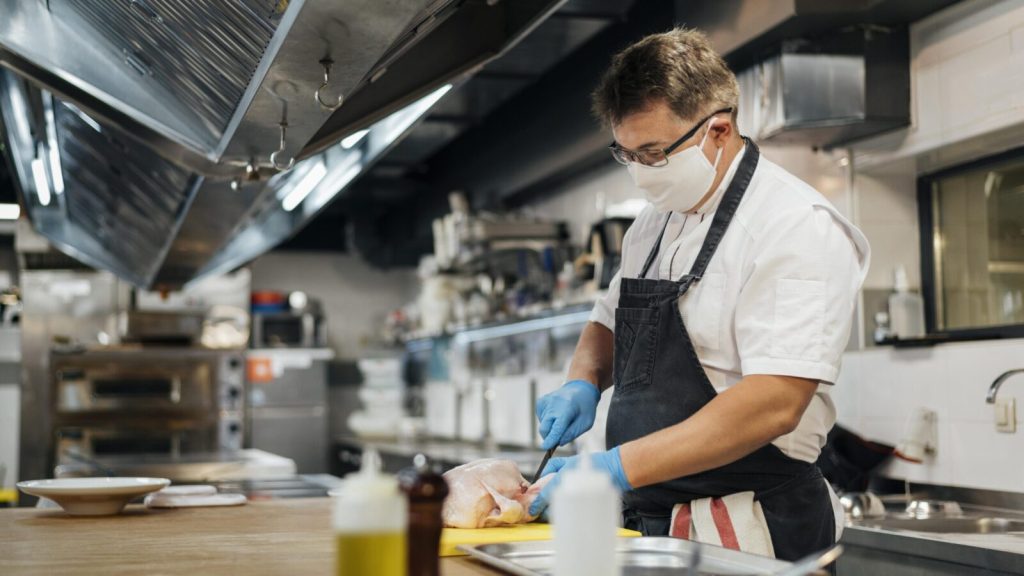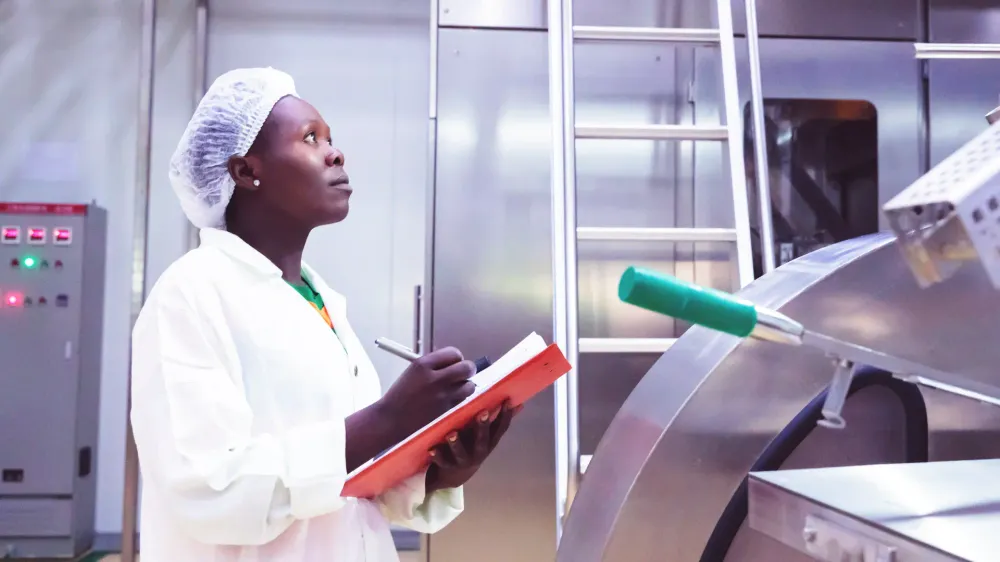
Essential PPE in the Food Industry: What You Need to Know
Overwhelmed by PPE options for food safety? Master your PPE selection for food workers safety with these practical tips.

Get 20€ off on your first order!
Effective sanitation practices are paramount in the food processing industry as there are various types of food products being processed and packaged, and the risk of contamination and foodborne illness is a significant and real threat.
Maintaining a clean and safe environment is essential to mitigate such risks, which is why you should always implement and adhere to rigorous sanitation practices.
However, before we continue, it’s important to clarify the fundamental difference between cleaning and sanitising.
Cleaning involves removing dirt, dust, and debris from a surface, object, or area. This can be done using soap and water, detergent, or other cleaning products
Sanitation is a process that involves reducing the number of bacteria, viruses, and other pathogens on a surface or object. Sanitising typically involves using chemicals or other disinfectants to kill or eliminate microorganisms. Proper sanitation helps to ensure that food products are safe and free from contaminants that can cause illness or spoilage.
In this article, we’ll walk you through the best practices for food processing plant sanitation, with a focus on the equipment and sanitation chemicals used in the process. We’ll also provide guidelines for developing an effective sanitation plan and schedule, employee training and hygiene, and other best practices to ensure a clean and safe food processing plant.
Here’s what you’re about to read:
 Proper sanitation helps to ensure that food products are safe and free from contaminants that can cause illness or spoilage.
Proper sanitation helps to ensure that food products are safe and free from contaminants that can cause illness or spoilage.
When it comes to food processing plant sanitation, utilising the appropriate cleaning equipment will ensure that surfaces and other food manufacturing tools are free from harmful bacteria and other contaminants.
There are several types of equipment needed for effective sanitation in a food processing plant. These include cleaning tools, disinfecting tools, and personal protective equipment (PPE).
Personal Protective Equipment (PPE): PPE is essential for protecting workers from harmful chemicals and pathogens. The type of PPE needed will depend on the task being performed and the chemicals being used. If you want to read everything about sourcing, using, maintaining and disposing of PPE for food processing, read our previous article: From Preparation to Packaging: A Complete Guide to PPE for Food Manufacturing.
All in all, your cleaning equipment for plant sanitation must be correctly used and maintained to be effective. This includes cleaning and storing sanitation equipment after use and regularly inspecting your tools for wear or damage. Any worn-out equipment should be replaced immediately to ensure your food processing plant is properly sanitised.
Chemicals are necessary to eliminate any potential pathogens that could pose a threat to public health, and that’s why the safety of food products for consumption heavily relies on them.
In food processing plant sanitation, chemicals are used to:
There are three types of chemicals used for effective sanitation in food processing plants: detergents and degreasers, disinfectants, and sanitisers.
Detergents and degreasers are typically used to remove dirt, grease, and other organic matter from surfaces, such as floors, walls, and processing equipment. Disinfectants are used to kill or inactivate bacteria, viruses, and other microorganisms on surfaces, such as worktables, cutting boards, and utensils. Finally, sanitisers are used to reduce the number of microorganisms on food contact surfaces to a safe level, typically after cleaning and disinfecting.
You can check our catalogue of cleaning chemicals for your food processing plant right here!
Of course, when dealing with sanitation chemicals is essential to prevent accidents and ensure the health and safety of workers in your food processing plant. Personal protective equipment such as gloves, goggles, and masks should be worn when handling these chemicals. You can read more about this in our previous blog post: From Preparation to Packaging: A Complete Guide to PPE for Food Manufacturing.
 Browse our comprehensive catalogue of cleaning tools and chemicals for your food processing plant
Browse our comprehensive catalogue of cleaning tools and chemicals for your food processing plant
The right approach to an effective food processing plant sanitation process starts with selecting the right cleaning tools, sanitation chemicals, and personal protective equipment.
However, cleaning tools and chemicals are not enough to ensure a clean and safe environment, which leads to one last essential step: developing and implementing an effective sanitation plan.
To guarantee proper sanitation, you should start by creating a sanitation plan that targets high-risk areas and equipment requiring extra attention, as well as establish standard operating procedures for cleaning and sanitising. This is a proactive approach that can help prevent food contamination and ensure compliance with regulations.
Of course, when it comes to implementing an effective sanitation plan for your food processing plant there’s no one-size-fits-all. That being said, here are some common best practices to get you started:
All in all, maintaining clean and safe food processing relies on a comprehensive sanitation program that should always include the use of appropriate equipment and chemicals, regular cleaning schedules and inspections, employee training, and adherence to regulations.
 Browse our comprehensive catalogue of cleaning tools and chemicals for your food processing plant
Browse our comprehensive catalogue of cleaning tools and chemicals for your food processing plant
Maintaining proper sanitation in a food processing plant is crucial to ensure the safety and quality of the food produced.
Effective sanitation equipment includes tools for cleaning, disinfecting, and personal protective equipment (also known as PPE). These tools must be maintained and inspected regularly to ensure that they function properly when needed. Also, make sure you’re using the right chemicals, such as detergents, degreasers, disinfectants, and sanitisers for the appropriate use case.
Moreover, you should always implement a comprehensive sanitation plan that identifies high-risk areas and establishes cleaning and sanitizing procedures, as well as create a schedule for cleaning tasks and equipment inspections, which can help to ensure that the facility is consistently cleaned and disinfected.
Of course, employee training on proper sanitation procedures, including the importance of handwashing and personal hygiene, is also crucial to maintaining a safe and sanitary food processing plant.
Next, you can check out our extensive catalogue of cleaning tools, supplies, and chemicals supplies for your food manufacturing facility – or click on the following product categories:
Thank you! You've signed up for our newsletter.



















Overwhelmed by PPE options for food safety? Master your PPE selection for food workers safety with these practical tips.

Struggling to maintain clear vision in demanding environments? This guide is here to help. By the end, you’ll know exactly...

Electricians across Europe face unique challenges that require reliable safety glasses to ensure both protection and efficiency. Whether safeguarding against...

Overwhelmed by PPE options for food safety? Master your PPE selection for food workers safety with these practical tips.

Struggling to maintain clear vision in demanding environments? This guide is here to help. By the end, you’ll know exactly...

Electricians across Europe face unique challenges that require reliable safety glasses to ensure both protection and efficiency. Whether safeguarding against...
Get 20€ off on your first order!
Save 30% by buying directly from brands, and get an extra 10€ off orders over €100
Save 30% by buying directly form brands, and get an extra 10€ off orders over €100